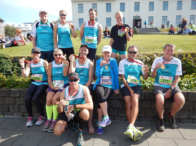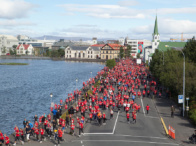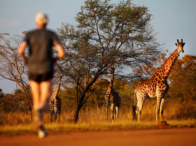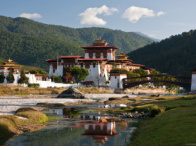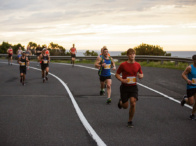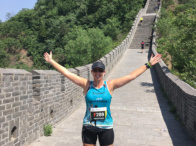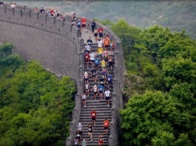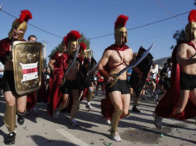In October this year I was fortunate to fulfill a dream of running The Marathon in Greece and although I have not produced a race report before, I felt compelled to put my thoughts and memories of this great event together.
Historical Background
When we run the modern Marathon we are celebrating a famous battle of the ancient world which occurred 2500 years ago this year. Although this might not seem relevant to the hundreds of thousands of people who run marathons all around the world each year, after one week in Greece you understand that to the Greeks “The Marathon” is much more than an endurance running event of 42.2 km.Such was the importance of the victory by the Athenians over the Persians at Marathon in 490 BC to the ancient Greeks that temples were built throughout the country. The victory at Marathon was also a very unlikely victory as the Athenians overcame a far superior army in both size and reputation.
The celebrated run of the soldier messenger Pheidippides back to Athens to tell of this great victory (I doubt he would have run that far if they had lost) created a story of mythical proportions that has survived the test of time and has created, with a little help from the modern Olympics, the sporting event that has now conquered the world. Understandably the Greeks today are very proud and passionate about the Marathon and if you mention to a Greek that you are running the Marathon their response is an enthusiastic “bravo, bravo” and to wish you luck. Compare that to the strange looks you get in Australia when you tell someone you are running a marathon! Another example of their passion for the event was in a restaurant following the Marathon when the owner wouldn’t accept payment for lunch after he heard I had run the Marathon the day before!
The Marathon Course
The Marathon course starts in between hills at the end of the plains of Marathon near where the battle took place and approximately 1-km inland from the Bay of Marathon. The course generally follows the “Marathonos Ave” which is now a 2 or sometimes 3 lane main road which follows the route of least resistance from Marathon to Athens and is believed to be the route used by Pheidippides 2500 years ago. Although there is some speculation over which route he took, any alternative route would have resulted in scaling some very steep mountains, which to me would have been unlikely.
From the start the course follows inland from the Bay of Marathon (part of the Aegean Sea), loops around the tomb of the Athenian soldiers killed at the battle (Marathon Tombs) then through the coastal villages of Nea Makri & Rafina, before starting the climb of over 22 km’s in between large mountains on both sides of the course. At exactly 31.5 km the uphill section finishes and you enjoy the gentle downhill or flat running through the outskirts and then streets of Athens to the finish line inside the ancient (rebuilt prior to the 1896 Olympics) white marble Panathenian Stadium. Note the entire stadium is finished in white marble and the high solid wall at track level to protect the crowd from either wild animals or disorientated marathon runners. Stadium holds 66,000 people.
Ancient Olympia
My wife Lily and I arrived in Greece 7 days before race day and the plan was to do two final training runs before the race day on the 31st October. The plan was also to run in the country during our 4 day “Classical Tour of Greece” which included Ancient Olympia, Delphi and Meteora.
We arrived in Olympia after dark on the first night of our tour and therefore I had no time to work out a running route for the next morning. So the next morning after a quick look at the map in the hotel foyer, I set off in total darkness and in the knowledge that I would be running the first hour without light in order to get the planned 20 km run in and not miss the tour bus departure. Our hotel was located high up on a hill overlooking ancient Olympia and as I started down the steep hill I could hear dogs howling from a number of locations around the town and surrounding hills which sounded quite eerie.
When I got down to the town itself I turned right and ran over a stone bridge and could hear but not see the river below. I knew I must be now close to the main Olympia historic area as I was aware that Ancient Olympia was built along the Kladeous River and near the junction with the Alpheios River. Soon after I crossed this bridge I could make out some large steel gates which were locked and then in the distance some spot lights highlighting a few Corinthian columns. This was clearly the main “Olympic Sanctuary” where I was keen to run, but as it was locked I continued on and along a road which ran parallel with the river and headed into the country. I had no idea where I was going but had to get my distance and time in and this road had no cars and seemed as good as any. After a couple of minutes I came to a clearing and could make out what looked like a field below and with the river on the far side of the field. This field was in fact the original Olympic stadium with its large grassed terraces but I couldn’t see that at this time and kept going on the basis that I would see more when I returned in better light.
As I continued down this road I half expected a wild dog to jump out at me as I could still hear the howling reverberating around the hills. After another 4 km I could make out a large building complex on the left, again with locked gates but as I ran around the side I could see a boom gate with a security guard. Keen to explore I ran up to the boom gate and waved to the guard, expecting to be told there was no entry. To my surprise he waved back and I entered what turned out to be the “Olympic Academy” built after WW2 to teach and promote the ideas of the Olympics. The Academy was built on a steep hill and the road I was following led to the top where a number of residences were located. As I approached the top of the hill I felt that I may have gone too far which was confirmed when a large guard dog started bearing down on me and howling at the top of his voice which must have woken everyone in the complex up and alerted the security guard below that not all was not well. I turned and tried to ignore the dog as I went slowly down the hill and fortunately the dog spared me on this occasion.
Returning to the bottom of the hill I then tried to find an alternative route out of the Academy in order to avoid the security guard at the entrance. After trying all other exits that were locked I had no alternative but to run past the boom gate again and to my surprise the security guard again smiled and waved as I went past. Quiet relieved I headed back the 4 km into town and toured around the historic sites and museums that were not locked but which were all still in darkness. Running back into the town I came upon some Americans also over for the Marathon, just starting out on their training run. The locals must have been concerned at the sight of all these international visitors running around their town so early in the morning.
It was starting to get light and with still some time to use up, I headed back over the stone bridge and to the entry to the Olympic Sanctuary. A side gate next to the main gates was now partly open and there was nobodythere so I just ran in, keen to explore the ruins. It was a bit like running through an ancient obstacle course and quite exhilarating. Each time I came to a turn in the path I turned left and within a short distance I could see a stone arch and headed towards it. As I approached the arch and started to run on large stone blocks it was evident that the arch was the last remaining section of an ancient tunnel, which lead into the Olympic stadium. I hadn’t even considered running around the oldest stadium on earth but with 10 seconds I was running around the outside of a large square track covered in fine gravel and with huge grass terraces all around. It was just starting to get light but was still deadly silent (apart from the wild dogs) and I could hear the crisp sound on each landing of my Brooks on the fine gravel of the track. As I looked up onto the terraces I tried to imagine what had occurred in this place almost 3000 years ago. It didn’t take a lot of imagination as the noise of the crowds in my mind seemed quite real.
I enjoyed the first lap so much that I decided to do another which was almost as good as the first and then started to run back out under the arch. As I went under the arch I could see a woman some distance away starting to talk to me and I thought she was asking directions so I started to say “yes its open”, however she was a park ranger of some sort and she started shouted to me that “nobody is allow the run in this place and you must leave immediately”. So I ran off after a brief apology and headed back to town and more runner friendly historic sites. Clearly I had been fortunate to run 2 laps on this sacred soil, on my own and in the dawn. I would have to wait another 5 days to find out if I had offended any pagan gods by running where I was not allowed.
Meteora
On the last day of our tour we stayed in Meteora a relatively small town made famous for the monasteries built high on the sheer cliffs of almost 400m in height overlooking the town. These monasteries were built by monks who originally lived in caves in the cliffs but over hundreds of years built these incredible buildings. The monasteries have been used in James Bond movies. I had met up with Jeff Dean from Boston in the US the only other runner on our tour and we set off early for a 10km run in the dark with rain and howling wind to contend with. We ran through the town and towards the cliffs on the outskirts of the town. Impressive scenery and a very historic town but not quite in the same league as ancient Olympia or Delphi that we had visited in the days before. We arrived back at our hotels wet and cold and hoped that our run would not result in a cold or flu before Sunday.
Marathon Expo and Opening Ceremony
The Marathon Expo was held in a magnificent building called the “Zanneion Metapon” located in the large “National Gardens” in the center of Athens. The Zanneion had an impressive internal multi-storey circular colonnaded courtyard with replica marble and bronze statues. The Expo included a display of all countries in the world where marathons are run on an annual basis. The vast majority of marathons are in Europe and the US with the maps of these countries peppered with dots at close intervals.
The Friday night before the Marathon the organizers held a ceremony in front of the Zanneion building with a large stage and screen and seating for quests. The ceremony started with a modern dance reinactment of the battle of Marathon performed by Greek maidens. During the performance the screen was used to show an actor dressed as Pheidippides starting his epic run to the Agora in Athens dressed in Athenian soldier’s attire. During the performance his run was interrupted by short excerpts from each Olympic Marathon from 1896 to 2008. Towards the end of the performance the actor from the film enters the crowd and is spotlighted as he makes his way through the audience and onto the stage and then to everyone complete surprise drops dead! This was met with great applause.
The organisers had chosen 9 “legendary” marathon runners to receive awards on the night including the current women’s Olympic champion Constantina Dita and past champions, Rosa Mota, Joan Benoit, and Stefano Baldini. Spyridon Louis sent his apologies. Before the awards were presented the head of the Hellenic Athletics Federation dedicated the 2500 year anniversary Marathon, to all marathon runners from around the world who were not running. All 12,500 runners from 89 countries who were running on Sunday had to pledge their support for the “international marathon movement” which promotes peace throughout the world and all runners were asked to take that message back to their own country. By writing this race report I have hopefully honored my pledge.
The Marathon Flame
In 2007 the Greeks started the practice of creating a “marathon flame” on the eve of the Athens Marathon in October from a continuous flame held inside the Marathon Tomb. In 2010 marathon flames were sent all over the world to race organisers holding official marathons with the idea that the flame will help promote the ideals of the marathon.
The Marathon Itself
Before The Race Start
Race day had arrived quicker than expected and I was fortunate that after much travelling and plane trips I was clear of any minor illnesses and still injury free. We were collected by bus from the center of Athens at 6.30am and dropped as close as possible to the start but the large number of other buses and pedestrians made it difficult for our driver to get us closer than 1km from the start. The normal mayhem associated with the start of any Marathon was evident. Most of the announcements were in Greek first followed by English and then French so you had to listen carefully. The majority of runners had specially printed running shirts for the event (including myself and the 50 other Australian and NZ runners in the Travelling Fit Group) with their countries or running clubs displayed. The Travelling Fit shirts were fantastic and the prominent “Australia” on the front and back resulted in extra cheering and “bravos” along the course. The day was to prove to me that there is definitely a strong bond between Australia and Greece.
The best “fancy dress” runners were a team of eight young German men all dressed as Spartan soldiers including helmets and swords. I am not sure why the young Germans were dressed as Spartan soldiers as the Spartans didn’t come to the aid of the Athenians in the battle, even though Pheidippides had run to Sparta the week before the battle asking for assistance and the Spartans had offered a paltry 1000 soldiers in ten days time which was of no use to the Athenians.
The race started at the relatively late time of 9 am and all the Travelling Fit runners were put in Start No.5, which had us starting officially at 11 minutes after the first start. This was contrary to the official program that advised that our start position would be based on our best marathon distance time in the last 2 years. As a result the faster runners in start 5 soon caught the back of start 4 and once through them we struck start 3. It was a bit like the bad old days in the City2surf in Sydney before timing chip and coloured bibs were introduced.
The Race
I started the race with two other Travelling Fit runners, Dave Brook from Perth and Anthony Lucas from Sydney. Discussions at the start line regarding our previous marathon times indicated that we were well suited to run together and the plan was to stick together where possible. Anthony and I were easy to spot in our Travelling Fit shirts while Dave although not wearing his race shirt is a big strapping lad and easy to spot in any crowd. I found out after the race that at the start all runners were asked to raise their right arm and take the “marathon oath”. Unfortunately in our section at least, this request or the oath itself could not be heard over the crowd of 12,000 odd runners.
We finally got to the start line and got the start 5 gun at 9.12am. Anthony and I started fast to try and get some free running as soon as possible. Dave looked a bit surprised in the first 3 or 4 km’s but he stuck to the plan of running together although this proved a challenge as we soon struck the tail of start 4 at about the 2 km mark and had to weave and duck our way around slower runners. We ran most of the first 5 km on the footpath as it was easier to pass other runners, the only problem was that most of the Greek spectators were also on the footpath shouting out “bravo bravo” and we had to be careful not to collide with them and often had to jump back onto the road where crowds completely covered the footpath. All this erratic running was taking up energy which we would have liked to conserve, but we didn’t have any alternative.
At about the 5 km mark I saw spectators holding out small olive tree branches to runners. I had been half expecting olives leaves to be handed out at the start as it is tradition for runners to drop olive leaves at the Marathon Tomb to show their respect to the fallen soldiers. We passed the 5 km mark and our Garmin GPS watches rang out to tell us our split time of 22.30. We were now very close to the sharp left turn that takes you round the Marathon Tomb and I was able to collect a small olive branch before the turn. I was not sure exactly where to drop the olive branch as the circle around the tomb is very wide and extends for 2 km or so. I was expecting to see a sign but in the end made my own decision on an appropriate spot, as running with a drink bottle and an olive branch and trying to drink at the same time can be difficult. Running around the Marathon Tomb I started to feel the heat of the sun which was already quite high in the sky and although I was well hydrated and don’t normally drink for the first 10 km of a marathon, I took my first drink and poured half the bottle over myself. I had thought long and hard before the race about the pros and cons of wearing a running cap or not, and in the end decided not to wear one on the basis that the sun would be above and behind us for most of the race rather than directly in our face. However the for the first 15 km we were running directly into the sun and even after 6 km I was starting to feel uncomfortable and I knew that the 22km’s of hills hadn’t even started. I was starting to doubt my decision.
Following the rounding of the Marathon Tombs we hit our first slight incline at 7.5 km which didn’t seem noticeable. The three of us passed the 10km mark and our watches advised a time of 46.30 indicating that we had backed off a bit in the last 5 km although I didn’t notice any change in pace. At 11 km we start to hit the first significant uphill section where we started to pass other runners at a greater rate. The crowds were now increasing in size and the number of “bravo, bravo” was also increasing. The runners were now thinned out enough for the crowds to focus on individual runners and as I pass many see my Travelling Fit Australia shirt which causes them to shout out “bravo Australia, bravo Australia” (with a Greek accent) and I wave and smile back.
Anthony, Dave and myself are still together at the 15 km mark and appear to running in reasonable comfort and ignorant bliss (not totally) what is about to start. The sun was now starting to come off my face and I started to feel a lot more comfortable. The temperature was around 20ºC and with constant water over my head, my body temperature was nicely under control. At the 18 km mark the first stage of the race is over and the serious uphill section starts and Dave starts to my surprise, pushes hard up this first major hill. At first I was expecting him to slow down but it soon became evident that he was a man on a mission to destroy the hills of the Marathon! Anthony was starting to struggle at this point and eventually we lost sight of him, while I managed to keep about 30 m behind Dave but was loosing distance at each drink station as I briefly stopped to refill my drink bottle. On two occasions I managed to sprint up to him but that took a lot of energy and after about 27 km he was out of sight and possibly 300 m or more in front of me. At this stage I was just happy to hold on and tackle these hills the best way I could and see what happens over the top.
The difficulty in running the hills was being assisted by the great cheering crowds of Greeks and “bravo, bravo Australia” and also by the changing angle of the sun as the Marathon route turns and starts to head straight at Athens. As we approached the last 3 km of hills (28.5 to 31.5 km) I was starting to get fed up with the relentless gradient which was now increasing and winding around so you could not see the end. I was deciding how to describe these hills to other runners when I got back to Australia, but before I was able to come up with something reasonable I was at what appeared to be the top and a look at my GPS watch, which was now set on distance not time, indicated that I was indeed at the 31.5 km mark and the gentle downhill that I was enjoying was not an illusion but the start of the third and final stage of the race.
At the top of the hills I was running just behind to two German runners who seemed to know the course and were very excited to be over the worst of it and shouted out very loudly in German something along the lines of “lets attack” and started to sprint off which surprised me. At this stage I focused on consistent running to avoid cramps in the legs which often strike after rounding large inclines, and trying to work out how much energy I had left. About 2 km later I passed the Germans who were now very quiet and had they heads down. Although I was suffering too, as per any marathon in the last 10 km, I wasn’t in any significant pain and felt that I could run ok to the finish. At this stage I had thrown out the window any ideas of running anywhere near 3.30 as I had figured that even after a fast start, the 22 km’s of hills would have pushed me way over my normal km splits and therefore I should just “enjoy the experience, soak up the atmosphere and don’t worry about your time” as everyone had told me before leaving Sydney. So I kept going and enjoyed the flat and gentle downhill of the next 7 km and enjoyed the sites of Athens, the cheers of the crowds which were becoming larger and larger and also the antics of some of the other runners. There was a young Greek runner in front of me dressed in national Greek colours with this name on this shirt. He was running at the same pace as me but he was winding up the crowd as he ran and they were responding enthusiastically in Greek. As we now at the 37 km mark of a marathon it was annoying me that even with all this carry on he was running at my pace and had done so for the last 3 or 4 km. It wasn’t until about the 40 km that the young Greek finally paid for his antics as although the crowds were now at their greatest he had succumbed to fatigue and fell silent.
At about the 38 km mark we passed an old Greek Orthodox Church with a cobblestone square in front and lots of children dressed up in Greek national costume. There were large speakers set up and as I passed they played “Jerusalem” which is a piece of music I associate with English rugby but was still very stirring and most appropriate for the final stages of the Marathon. At this point an old Greek man saw my shirt and cheered me and then thanked me for coming all the way from Australia to run the Marathon! Pity I could not stop and chat. While all this was going on I had not given Dave another thought as I assumed he was well in front and running nicely to the white marble of the Panathenic stadium. This was not the case and at about the 37 km mark he had become dizzy and almost collapsed even though he that taken with him enough sports gels and bars to sink a battleship. He managed to recover after drinking and walking some distance and ran the last 5 km solidly and finished less than a minute behind me. Anthony was somewhere behind and we later found out that he had got to the 31.5 km mark not too far behind Dave and myself but then had struggled through the last 10 km.
At about 39 km I changed my watch display from distance to time and to my surprise I saw 3.15 on the dial. I suddenly realised that bar any disasters I would run under 3.30. This gave me a target and extra focus and I pushed on as hard as I felt I could for the last 3 km, although I was starting to hurt and could feel a few niggles in my legs so was concentrating hard on my running form. There was one nasty but short uphill at about 41km and then on to the stadium. The last 500m downhill before entering the stadium was absolutely packed with spectators and the noise from the crowd was incredible. I wasn’t aware that I was so close to the finish as the stadium was hidden behind some large buildings close to the road so I had not calculated when I should pick up the pace to the finish line. At the bottom of this road you turn left and you have only 50m before entering the Panathenic Stadium. As I entered the stadium they were playing very very loud Greek dancing music which muffled the cheers of the crowd.
Crossed the line and felt pretty good but forgot to say “nenikikamen“. After walking around the track towards the recovery area Dave spotted me and told me of his near collapse and remarkable recovery. He thought he had run 3.29 and my watch said I ran 3.27 (programmed to stop at 42.2 km) but in reality there was less than a minute between us and both were thrilled with our times on this course in this historic Marathon. Both times will in theory enable us to run the 2012 Boston Marathon. A review of results a week later indicated that I had finished in 830th place and was the 5th Australian on the day. Dave came in 892nd place and according to my assessment was the first NZ runner home on the day. Anthony finished right on 4 hours, which is 30 minutes off his normal marathon time which was not uncommon with other runners I spoke to. My wife Lily had been patiently waiting in the stadium for my finish. Again thanks to the Travelling Fit shirt she was able to spot me and managed to get some good photos of me running in the stadium and near the finish line which was great.
Post Race
A party was held that night for all the Travelling Fit runners on the rooftop garden of the Plaka hotel in the middle of Athens, which looks directly onto the floodlight Acropolis and with the magnificent Parthenon. An amazing view. There were a few horror stories from the race including physical sickness during the race and torn ligaments but all the Travelling Fit runners finished and all had many great memories to take home. The organisation of the event was first class (apart from the starting position problem) and Greeks created a modern event but with all the history and passion that only the home of the Marathon could deliver.
My wife and I were treated like VIP’s throughout Greece, the historic sites and museums are outstanding and it is definitely a great place for a holiday. Thank you to Travelling Fit and their Greece affiliates Pam Tours in Greece for giving us the opportunity of taking part in this event. It was a great adventure.
Richard Duggan
Post Script
Yes the young Germans finished the race, as they had started, in full Spartan attire and in a very impressive time of around 4.30. Bravo!!!






